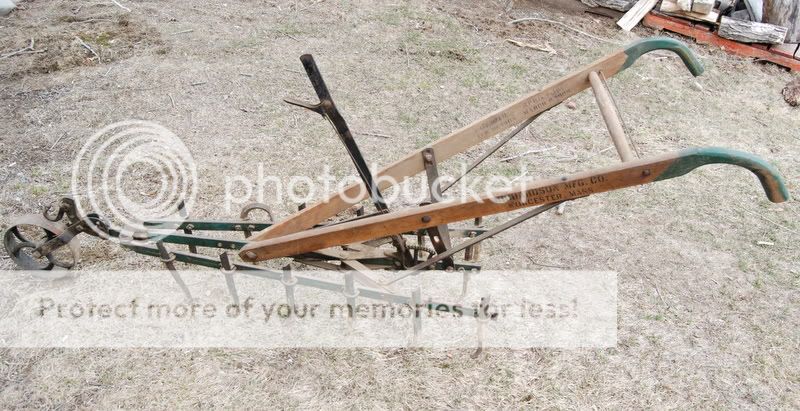Hello! My family and I are having the HARDEST time identifying this John Deere implement. It looks like a ditching plow that throws both ways. The furrow can be widened or narrowed. It doesn't appear to function as a hillside plow but what do I know. I know that a walking plow like this is generally a horse or mule drawn implement, but considering the John Deere association, I'm hoping someone can help me. Images below.
The handle is marked, on one side, "MFD. FOR JOHN DEERE CO. SYRACUSE, NY." The other handle is stenciled, cryptically, "SHAWNEE" in quotations. There is no clear number on the beam. I believe it is a Syracuse Chilled Plow Company plow from 1911-1915, sold through John Deere dealers (my grandfather was a JD dealer in Maine) after the 1910 acquisition. It was stored in my barn with a Richardson MFG Co. steel tooth harrow nearly exactly the same size. Being essentially a Syracuse Chilled Plow design, I don't expect to find the normal beam numbers. There are other numbers though. Many parts are stamped marked with an E and three digits, like E597 or E515. There is also, on the back of the moldboard, a stenciled "SL-5715-E".
There is a good chance this is a display or demonstration model my grandfather had. He died in 1927, and the family had little to do with agriculture after he passed. We'd really like to identify the purpose of this implement, and the model number.




The handle is marked, on one side, "MFD. FOR JOHN DEERE CO. SYRACUSE, NY." The other handle is stenciled, cryptically, "SHAWNEE" in quotations. There is no clear number on the beam. I believe it is a Syracuse Chilled Plow Company plow from 1911-1915, sold through John Deere dealers (my grandfather was a JD dealer in Maine) after the 1910 acquisition. It was stored in my barn with a Richardson MFG Co. steel tooth harrow nearly exactly the same size. Being essentially a Syracuse Chilled Plow design, I don't expect to find the normal beam numbers. There are other numbers though. Many parts are stamped marked with an E and three digits, like E597 or E515. There is also, on the back of the moldboard, a stenciled "SL-5715-E".
There is a good chance this is a display or demonstration model my grandfather had. He died in 1927, and the family had little to do with agriculture after he passed. We'd really like to identify the purpose of this implement, and the model number.






